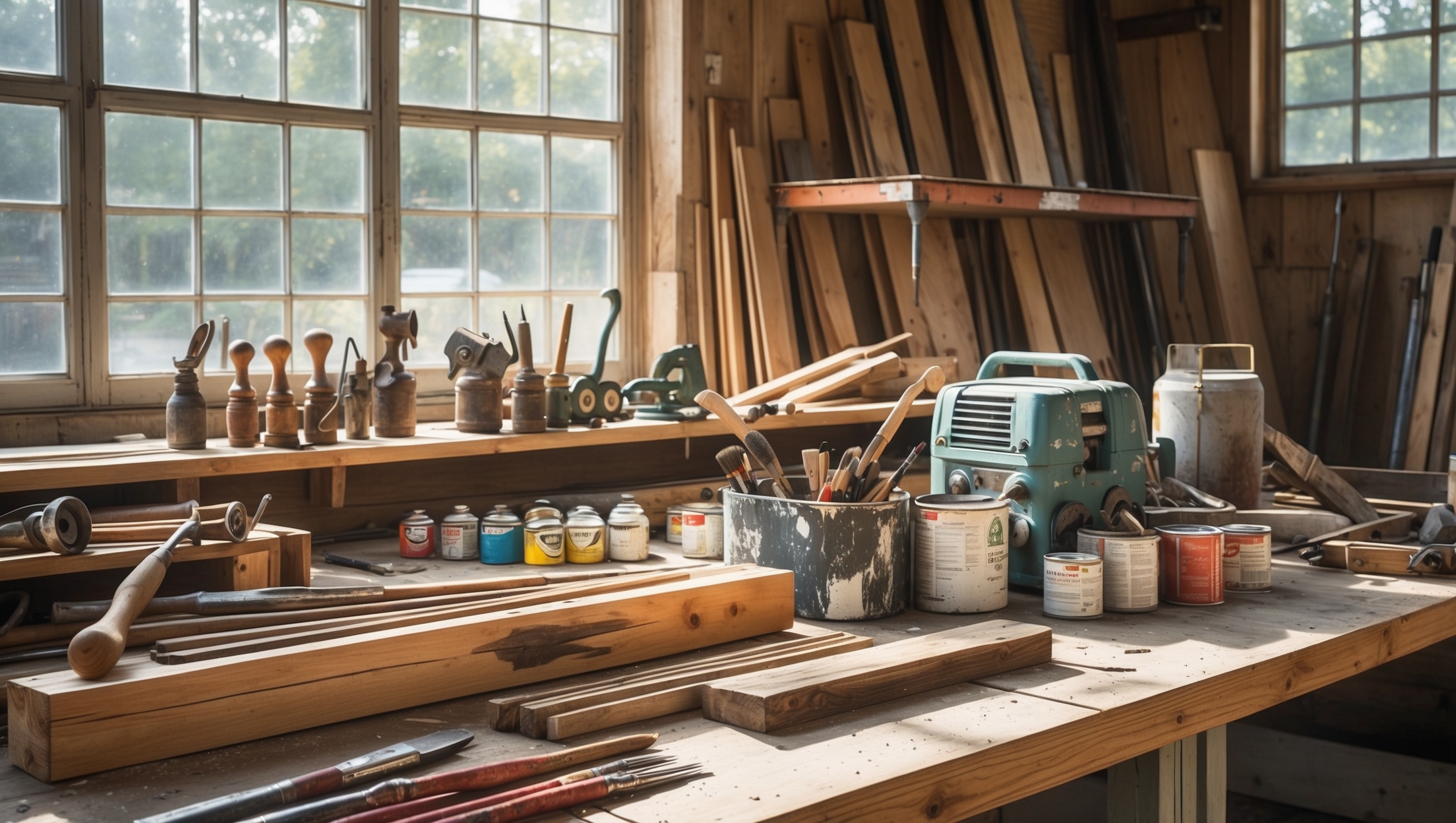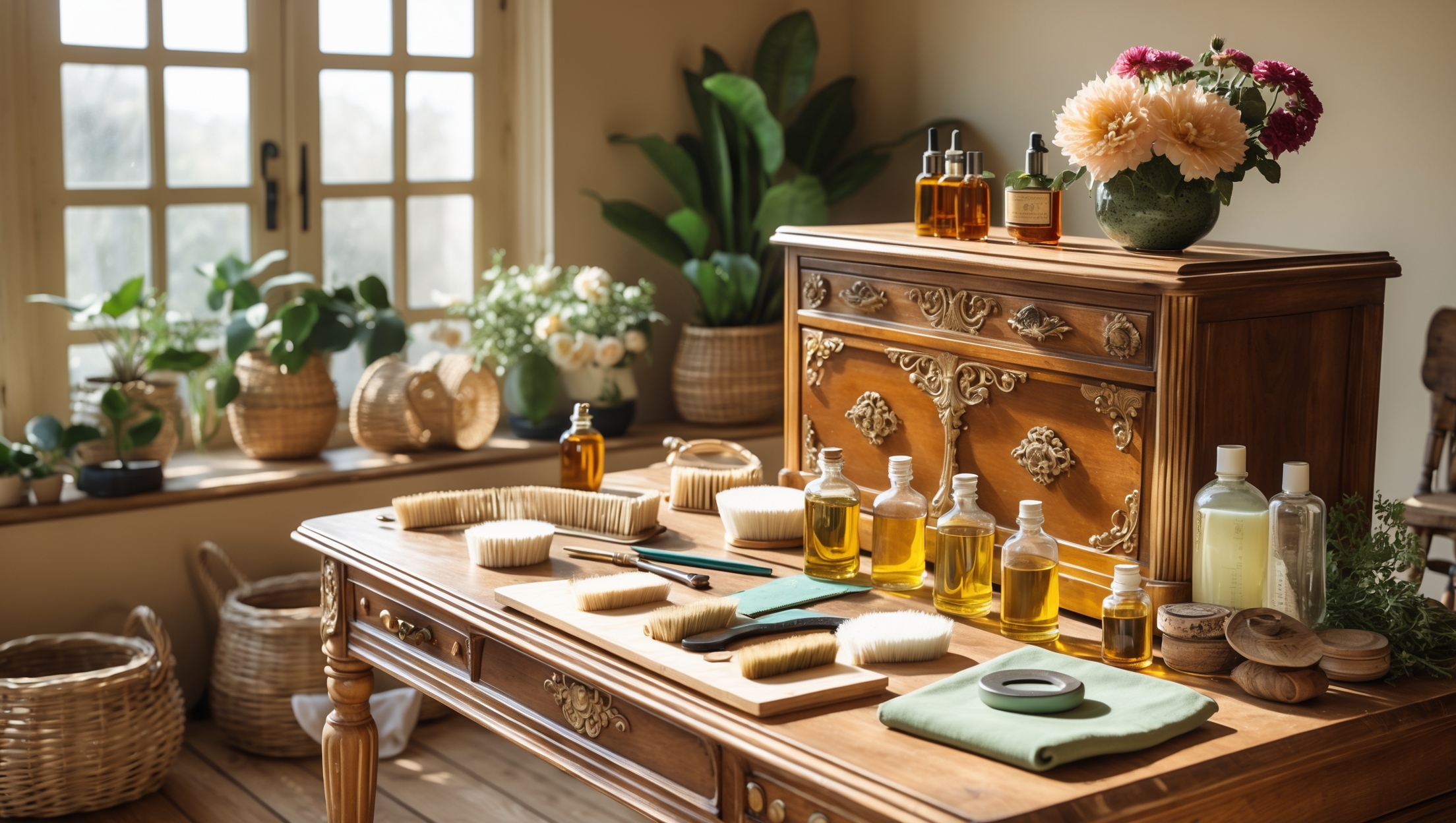Introduction: The Right Tools Make All the Difference in Upcycling
Upcycling and creative salvage are more than just trends—they’re practical, sustainable paths to personal expression and resourcefulness. Yet, every successful project depends on having the right tools on hand. Whether you’re transforming a battered desk into a chic console table, rescuing old fixtures, or crafting bespoke décor from found materials, your toolkit can mean the difference between frustration and fulfillment. But with aisles of options and conflicting advice, how do you know what you really need? This comprehensive guide unlocks the essentials of tool selection for upcycling. We’ll demystify hand tools versus power tools, delve into specialty equipment for wood, metal, and mixed media, and offer expert tips on quality, safety, and smart upgrades. You’ll learn not just what to buy, but why, when, and how to use each tool, tailored to creative salvage. Whether you’re a beginner building your first toolkit or a seasoned DIYer looking to refine your gear, you’ll find practical advice for every level and project type. Let’s open the toolbox and get started!
Why Tool Selection Matters in Upcycling
Unlike standard home improvement, upcycling often means working with unpredictable materials—aged wood, corroded metal, composite furniture, or rescued hardware. Each material presents unique challenges, and mismatched tools can lead to damage, wasted time, or even injury. A curated, quality toolkit empowers you to:
- Work safely and efficiently
- Preserve the integrity of salvaged materials
- Achieve professional-quality finishes
- Reduce project costs by avoiding mistakes
- Enjoy the creative process with fewer frustrations
Let’s break down the essential equipment for every upcycler.
Core Hand Tools: The Foundation of Every Upcycling Toolkit
1. Measuring & Marking
- Tape Measure (16-25 ft): Reliable, with a locking mechanism. Essential for accurate cuts and layouts.
- Steel Ruler & Square: For precise marking, squaring corners, and checking alignment.
- Marking Tools: Carpenter’s pencils, fine-tip permanent markers, and chalk for different surfaces.
2. Cutting & Shaping
- Handsaw (Crosscut & Back Saw): For wood, trim, and quick cuts when power isn’t practical.
- Utility Knife: Heavy-duty blades for trimming, scoring, and general use.
- Metal Snips: For cutting sheet metal, wire mesh, or tin.
- Chisels (Wood & Metal): For removing old glue, shaping, or cleaning up joints.
3. Assembly & Fastening
- Claw Hammer: For driving and removing nails. Choose a comfortable, medium-weight model.
- Screwdriver Set: Flathead, Phillips, and Torx in multiple sizes. Magnetic tips are a plus.
- Pliers (Slip Joint, Needle Nose, Locking): For gripping, bending, and pulling nails or fasteners.
- Adjustable Wrench: Handles bolts and odd-sized hardware commonly found in salvage.
4. Surface Prep & Finishing
- Paint Scraper: Essential for removing old paint, adhesives, or grime.
- Sanding Block: For smoothing surfaces or prepping for finishes where power sanders are too aggressive.
- Wire Brush: Cleans rust and corrosion from metal finds.
5. Safety Essentials
- Work Gloves: Choose cut-resistant gloves for handling metal and splintery wood.
- Safety Glasses: Protects against flying debris, especially when cutting or sanding.
- Dust Mask/Respirator: Prevents inhalation of sawdust, paint particles, or old insulation.
Power Tools: When to Invest and What to Prioritize
Power tools can dramatically speed up your workflow, but they also require a higher upfront investment. Here’s how to decide when to upgrade and which tools offer the most versatility for upcyclers.
Must-Have Power Tools for Upcycling
- Cordless Drill/Driver: Indispensable for drilling holes and driving screws. Choose a reputable brand with variable speed and a good battery system.
- Orbital Sander: Makes surface prep and finishing fast and uniform, especially for large salvaged pieces.
- Jigsaw: Enables curved and straight cuts in wood, plastic, and some metals. Look for tool-free blade changes and adjustable speeds.
Nice-to-Have Power Tools
- Circular Saw: For breaking down large boards or reclaimed lumber efficiently.
- Angle Grinder: Excellent for cutting, grinding, and cleaning up metal salvage.
- Heat Gun: Useful for stripping paint or softening adhesives on old furniture.
Tips for Power Tool Selection
- Opt for tools with variable speed and ergonomic grips for better control.
- Purchase from brands with good support and readily available replacement parts.
- Consider battery compatibility if you plan to expand your cordless tool collection.
Specialty Tools for Salvage Projects
1. For Wood Restoration
- Wood Planer: Hand or electric, for smoothing and resizing reclaimed boards.
- Putty Knife: Applies fillers or removes residue from surfaces.
- Detail Sander: Great for getting into corners and intricate designs found in vintage furniture.
2. For Metal Upcycling
- Metal File Set: Rounds off sharp edges and smooths rough cuts.
- Pop Rivet Gun: Joins thin metal pieces without welding—handy for industrial upcycle projects.
- Magnet on a Stick: Retrieves lost hardware from tight spaces.
3. For Mixed Media & Creative Detailing
- Rotary Tool (e.g., Dremel): Sand, engrave, cut, or polish small details on almost any surface.
- Staple Gun: For attaching fabrics, webbing, or backing to upcycled seating and panels.
- Glue Gun (High & Low Temp): Bonds materials quickly; high-temp for wood, low-temp for delicate items.
Choosing Quality: What to Look for in Tool Construction
Cheap tools often cost more in the long run due to breakage, poor performance, or even accidents. Here’s what to check before buying:
- Material: Hardened steel for blades and cutting edges; solid, non-slip handles for comfort and safety.
- Weight & Balance: Tools should feel comfortable and balanced in your hand, not overly heavy or awkward.
- Moving Parts: Smooth operation, no excessive play or wobble in mechanisms.
- Warranty: Prefer brands offering multi-year or lifetime warranties—an indicator of quality and support.
If buying secondhand, inspect for rust, cracks, missing parts, and ensure moving components operate smoothly.
Building Your Toolkit: Starter, Intermediate, and Expert Levels
Starter Toolkit (For Beginners)
- Tape measure and square
- Handsaw and utility knife
- Hammer and basic screwdriver set
- Slip joint pliers
- Sanding block, paint scraper, wire brush
- Work gloves, safety glasses, dust mask
This setup covers basic disassembly, surface prep, and small repairs—perfect for upcycling picture frames, stools, or small shelves.
Intermediate Toolkit (For Frequent Upcyclers)
- Add cordless drill/driver and orbital sander
- Metal snips, chisel set, adjustable wrench
- Detail sander and staple gun
- Glue gun
- Rotary tool
This allows for more ambitious projects like furniture restoration, metalwork, or reupholstering chairs.
Expert Toolkit (For Professional or Large-Scale Projects)
- Circular saw, jigsaw, angle grinder
- Wood planer, metal file set, pop rivet gun
- Heat gun, multi-tool (oscillating tool)
- Comprehensive screwdriver and pliers set
- Specialty clamps and vises
This kit supports large-scale salvage, custom builds, and complex mixed media creations.
Tool Maintenance: Protect Your Investment
Cleaning and Storage
- Wipe down tools after each use to prevent rust and residue buildup.
- Store metal tools in a dry place; use silica gel or rust inhibitors for added protection.
- Sharpen blades and replace worn parts as needed—dull tools are dangerous and ineffective.
Power Tool Upkeep
- Clean dust and debris from vents and moving parts after every use.
- Check cords, batteries, and attachments for wear or damage regularly.
- Lubricate moving parts according to manufacturer instructions.
Safety First: Essential Gear and Habits
Regardless of your skill level, always prioritize safety. In addition to gloves, glasses, and dust masks, consider:
- Hearing Protection: Use earplugs or earmuffs when running power tools for extended periods.
- Apron or Coveralls: Protects clothing and skin from dust, splinters, and spills.
- First Aid Kit: Stock your workspace with bandages, antiseptic, and burn cream.
- Clear Workspace: Keep floors and benches free of clutter to avoid accidents.
Always read tool manuals and respect their limitations—never force a tool to do a job it wasn’t designed for.
Budgeting for Tools: Buy New, Used, or Rent?
When to Buy New
- For tools you’ll use on every project (hammer, drill, sander), invest in new, quality models with warranties.
When to Buy Used
- Hand tools and some power tools can be bought secondhand if they’re in good condition. Check for reputable sellers or community tool libraries.
When to Rent
- For specialty or expensive equipment (planers, large saws) needed only occasionally, renting saves money and storage space.
Always factor in the cost of accessories—blades, bits, batteries, and safety gear—when budgeting for tools.
Tool Hacks and Creative Problem-Solving
Upcyclers often face unique challenges—odd fasteners, mismatched hardware, or fragile materials. Here are a few expert hacks to make your toolkit even more versatile:
- Use painter’s tape to mark cut lines or prevent wood splintering when sawing.
- Magnetize your screwdriver tip by rubbing it with a strong magnet—makes working with small screws easier.
- Old toothbrushes make perfect detail cleaners for intricate carvings or hardware.
- Keep a small container for salvaged screws and nails—you’ll be surprised how often they fit vintage finds.
- Repurpose old credit cards as glue spreaders or paint scrapers for delicate surfaces.
Expanding Your Toolkit: When and How to Upgrade
- Upgrade when your current tools slow you down or limit your project scope.
- Look for features that improve comfort (ergonomic handles), performance (variable speed), or safety (automatic shutoff).
- Attend tool swap meets or join local maker spaces for hands-on trials before buying high-end tools.
- Stay organized with a tool chest or wall-mounted storage—efficiency saves time and reduces frustration.
Conclusion: The Right Tools Empower Creative Salvage
In upcycling, your toolkit is more than a collection of objects—it’s your creative partner. The right tools unlock the potential of salvaged materials, letting you shape, restore, and reinvent with confidence. By investing thoughtfully in quality equipment, maintaining it well, and learning how to use each tool safely, you set yourself up for success, whether your project is a simple shelf or an ambitious furniture overhaul. Remember: it’s not about having every gadget, but about building a toolkit that matches your interests, skills, and the materials you love to work with. Start with the basics, upgrade as you grow, and let each new project inspire practical additions. With the right gear at your fingertips and a commitment to safety and care, upcycling becomes a deeply rewarding, sustainable pursuit—one where every creation is as unique as your toolkit itself. So open your toolbox, gather your salvaged finds, and let your next restoration adventure begin!





I’m building my first upcycling toolkit and want to avoid buying unnecessary tools. Which hand tools would you say are truly essential for beginners who mostly work with small furniture pieces, and are there any budget-friendly options that still offer decent quality and safety?
For small furniture upcycling, the most essential hand tools are a good claw hammer, a set of screwdrivers (flathead and Phillips), a measuring tape, a hand saw, a sanding block, and pliers. For safety, include sturdy work gloves and protective glasses. Brands like Stanley and Irwin offer reliable, budget-friendly options. Buying a starter set can also save you money while ensuring you get the basics you’ll use most often.
Could you elaborate on your recommendations for power tools versus hand tools when working with mixed media projects, especially for someone who’s just getting into upcycling and isn’t sure which investments to prioritize?
For beginners in upcycling mixed media, hand tools like screwdrivers, pliers, and a handsaw offer more control and are often safer as you build skills. Power tools, such as a cordless drill or a jigsaw, can speed up work on tougher materials, but they require careful handling. Start with a basic hand tool set, then add simple power tools as your confidence grows. This approach keeps your initial investment low and helps you learn proper techniques.
I noticed the article emphasizes the importance of safety and preserving material integrity. Could you share more about which types of protective gear you consider essential for upcycling, beyond the basic goggles and gloves, especially when working with old or composite materials?
Absolutely, safety goes beyond just goggles and gloves, especially with older or mixed materials. Consider using a quality dust mask or respirator to protect against inhaling particles, especially if there’s old paint or adhesives involved. Hearing protection is useful if you’re doing cutting or sanding. Long-sleeved clothing and work aprons help prevent skin contact with irritants or sharp edges. Sturdy closed-toe shoes and knee pads can also make projects safer and more comfortable.
You mention that having a quality toolkit helps avoid mistakes and reduce project costs, but for someone just starting out, how do you decide which tools are actually worth investing in up front versus which ones can wait until you take on bigger or more complex upcycling projects?
When you’re just starting with upcycling, focus on buying a few versatile, good-quality basics: a solid hammer, a set of screwdrivers, measuring tape, utility knife, and pliers. These tools will handle most beginner projects. Wait on specialty items like power sanders or jigsaws until you find yourself needing them for specific, more advanced projects. This way, you avoid overspending and only invest more as your skills and project complexity grow.
I’m pretty new to upcycling and I get overwhelmed by all the hand tool options out there. You mentioned prioritizing quality equipment—are there specific brands or features to look for in basic measuring and marking tools that make a noticeable difference for beginners?
For beginners, sturdy measuring tapes with clear, easy-to-read markings can make a real difference—brands like Stanley or Komelon are often reliable. For marking tools, opt for pencils with fine tips and consider a metal ruler for durability and precision. Features like non-slip grips and magnetic tips on tape measures are helpful extras. Prioritizing accuracy and comfort in these basics will pay off as you start more projects.
I noticed the article mentions both hand tools and power tools for upcycling different types of salvaged materials. Could you elaborate on when it’s really necessary to invest in power tools versus sticking with high-quality hand tools, especially for someone who’s just getting started?
Power tools become necessary when you need to handle tougher materials or want to save time on repetitive tasks, like sanding large surfaces or making precise cuts in thick wood or metal. However, for beginners working on smaller projects with wood, fabric, or light metals, quality hand tools are usually enough. Start with hand tools to build your skills, and consider investing in power tools once you feel confident and need extra efficiency or versatility.
I noticed you mention the importance of matched tools for different materials like aged wood and corroded metal. For someone who does a mix of both, would you recommend investing in separate sets of tools or are there versatile options that can safely handle both materials?
If you often work with both aged wood and corroded metal, look for versatile tools that are designed for multi-material use. For example, certain sanders, wire brushes, and saws have interchangeable blades or attachments suitable for both wood and metal. However, some specialized tools—like wood chisels or metal files—are best kept separate to prevent dulling or damage. Investing in a core set of quality versatile tools, plus a few material-specific items, is usually the most practical solution.
I noticed you touch on the importance of matching tools to materials, especially when dealing with aged wood or corroded metal. Could you elaborate on which hand or power tools are most likely to cause damage to salvaged materials if chosen incorrectly?
Using the wrong tools can definitely harm salvaged materials. For aged wood, avoid aggressive power sanders or circular saws with coarse blades, as they can strip away patina or cause splintering. For corroded metal, steer clear of grinders or wire wheels that are too abrasive, since they may thin the metal or leave deep scratches. Hand tools with sharp, well-maintained edges are often safer for delicate work on old materials.
When determining whether to invest in hand tools or power tools for upcycling, do you have any guidance on prioritizing which tools to buy first if you’re working with a limited budget? I’m especially curious about which tools tend to give the most versatility for beginners.
If you’re starting out on a budget, hand tools are often the best place to begin since they’re affordable and versatile. For most upcycling projects, a good tape measure, hammer, screwdrivers, utility knife, and a hand saw will cover a lot of tasks. As you gain experience or if you find yourself repeating certain tasks, you can add basic power tools like a cordless drill or a jigsaw, both of which offer a lot of value for their price and can speed up your work.
For someone just starting out, how can I balance quality and cost when choosing essential upcycling tools? Are there specific items you’d recommend prioritizing first if I’m on a tight budget but want to avoid frustration and mistakes?
Start by investing in versatile, good-quality basics like a sturdy measuring tape, a reliable utility knife, and a set of screwdrivers—these will serve you well in most upcycling projects. Shop for mid-range brands instead of the cheapest options, as they tend to last longer and perform better. Consider secondhand tools or borrowing items you’ll use less often to save money. Prioritize tools based on the types of materials you plan to work with most frequently.
I’m usually fixing things late at night when the kids are asleep, so I’m curious—are there certain hand tools you recommend that are quieter or less disruptive than others for upcycling old furniture?
If you’re working late at night, manual hand tools are a great choice since they’re much quieter than power tools. Consider using a hand saw instead of an electric one, a manual screwdriver instead of a drill, and sanding blocks rather than power sanders. Wood glue and clamps are also silent options for joining parts. These tools let you upcycle furniture without disturbing the household.